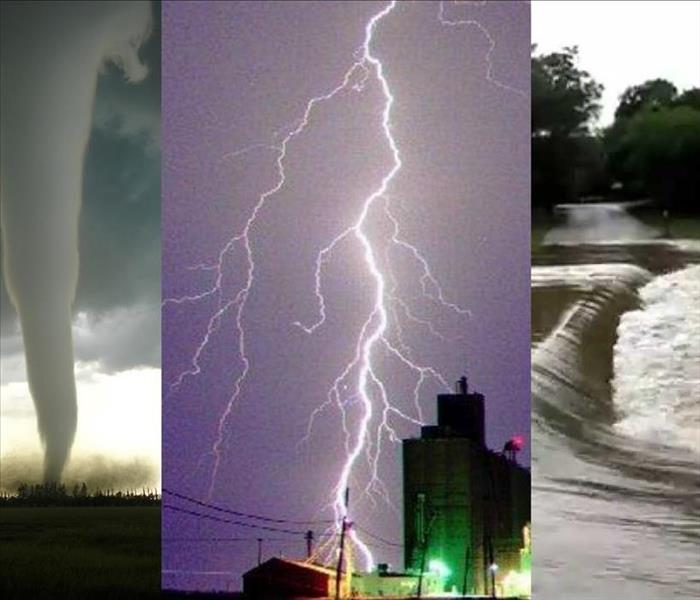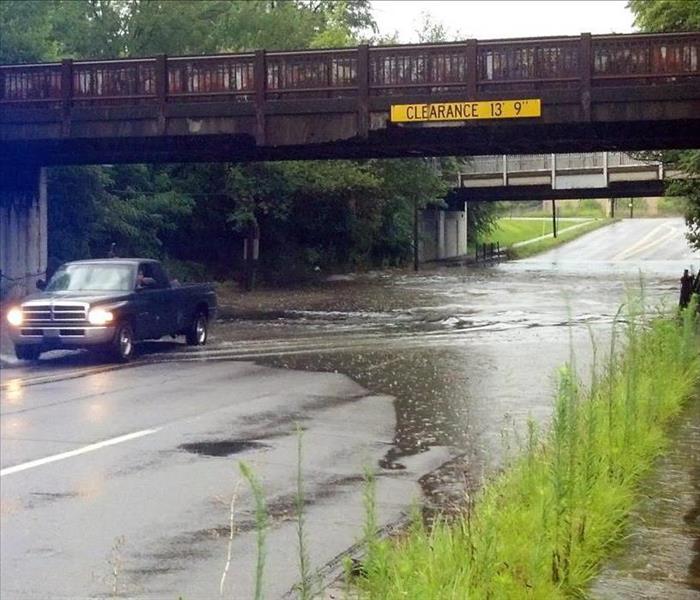Archived Storm Damage Blog Posts
Storm/Hurricane Safety
9/20/2024 (Permalink)
Being prepared is always the safest option.
Storm and hurricane preparedness is crucial for minimizing potential house damage and ensuring the safety of occupants. Additionally, it’s wise to review insurance policies to ensure coverage for flood and wind damage to your home.
We recommend having an emergency plan in place that is clear for each member of the household. An emergency plan for storms/hurricanes should include the following:
- Communication Plan: Designate a primary contact person and establish a method for checking in with family members during and after the storm.
- Emergency Kit: Assemble a kit with essentials such as water, non-perishable food, medications, flashlights, batteries, first-aid supplies, and important documents.
Evacuation Routes: Identify safe routes and nearby shelters, ensuring everyone knows where to go in case of evacuation.
Meeting Place: Establish a designated meeting location both near your home and further away in case of separation.
Pet Plan: Include arrangements for pets, such as food, carriers, and identification tags.
By covering these areas, families can enhance their readiness and safety during severe weather events.
National Preparedness Month: Storm Prep
9/27/2023 (Permalink)
Preparation isn't about convenience, rather the relief that you did."
During this time of year in Mississippi we not only experience a lot of heat but also rain, which includes thunderstorms. It’s important to be prepared and have a plan in place. Talk with your family and create an emergency plan for thunderstorms, floods, and hurricanes. It would be beneficiary to think about an emergency shelter and evacuation plan. Below, we have a few suggestions to make sure you and your family are ready for whatever happens.
Protect Your Electronics
Your electronics can get fried if they are not properly protected. Plug electronics into a surge protector to avoid damage during a storm.
Prepare for Power Outages
Have battery-operated flashlights and lanterns in easy to get to places. Check on these items from time to time to make sure the batteries still work, replace them if necessary. Also, think about keeping the refrigerator and freezer doors shut to keep food from spoiling. If these food items rise above 40 degrees for 2 hours or more, they should be disregarded. Call your local power company to inform them of the outage and to get information regarding when the power should be restored.
Stay Away from Power Lines
Do not go near power lines should they fall to the ground, they can be very hazardous. Call 911 if you see downed power lines.
Don't Stay Outside
If you hear thunder, it is likely that lightning is also occurring. Lightning can be dangerous, therefore, make sure to go inside when thunder occurs.
Seek shelter
There are many different natural elements which can occur and be harmful when outside during a disaster. Therefore, during a storm, it is important to seek shelter and be safe. If you're inside, a good place to be is at the lowest level of your home. If you have a basement or storm cellar you can hang out in until the storm passes.
Handy Emergency Kit
Consider putting together a kit of things you may want to have on hand during a storm. Items you may want to include would be water, non-perishable food, flashlights, blankets extra batteries, a radio, and a first aid kit.
If disaster does strike your home during a storm, your SERVPRO friends are ready to be apart of the team that pieces it back together. #SERVPROStrong
(205) 926-6010
National Preparedness Month: Storm Evacuation Tips
9/1/2022 (Permalink)
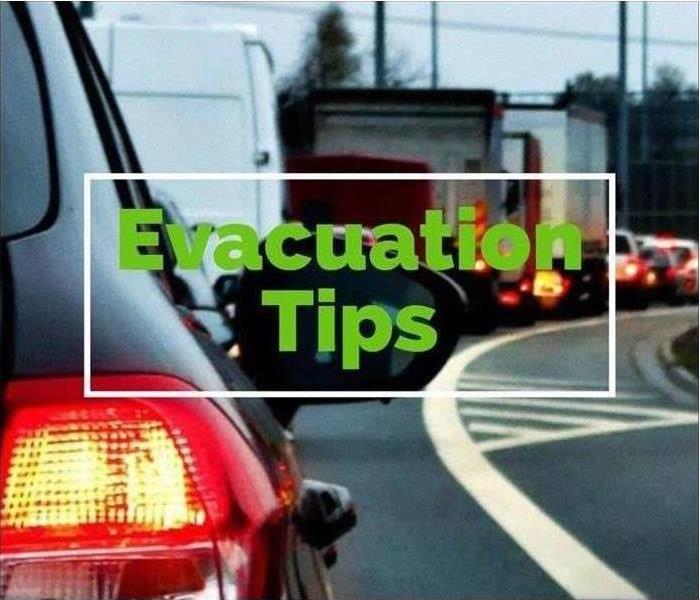 Be prepared during this hurricane season
Be prepared during this hurricane season
Before an Evacuation
Plan how you will leave and where you will go if you are advised to evacuate.
- Identify several places you could go in an emergency such as a friend’s home in another town or a motel. Choose destinations in different directions so that you have options during an emergency.
- If needed, identify a place to stay that will accept pets. Most public shelters allow only service animals.
- Be familiar with alternate routes and other means of transportation out of your area.
- Always follow the instructions of local officials and remember that your evacuation route may be on foot depending on the type of disaster.
During an Evacuation
- A list of open shelters can be found during an active disaster in your local area by downloading the FEMA app
- Listen to a battery-powered radio and follow local evacuation instructions.
- Take your emergency supply kit.
- Leave early enough to avoid being trapped by severe weather.
- Take your pets with you, but understand that only service animals may be permitted in public shelters. Plan how you will care for your pets in an emergency now.
- If time allows:
- Call or email the out-of-state contact in your family communications plan. Tell them where you are going.
- Secure your home by closing and locking doors and windows.
- Unplug electrical equipment such as radios, televisions and small appliances. Leave freezers and refrigerators plugged in unless there is a risk of flooding. If there is damage to your home and you are instructed to do so, shut off water, gas and electricity before leaving.
- Leave a note telling others when you left and where you are going.
- Wear sturdy shoes and clothing that provides some protection such as long pants, long-sleeved shirts and a hat.
- Check with neighbors who may need a ride.
- Follow recommended evacuation routes. Do not take shortcuts; they may be blocked.
- Be alert for road hazards such as washed-out roads or bridges and downed power lines. Do not drive into flooded areas.
After an Evacuation
If you evacuated for the storm, check with local officials both where you’re staying and back home before you travel.
- Residents returning to disaster-affected areas after significant events should expect and prepare for disruptions to daily activities, and remember that returning home before storm debris is cleared is dangerous.
- Let friends and family know before you leave and when you arrive.
- Charge devices and consider getting back-up batteries in case power-outages continue.
- Fill up your gas tank and consider downloading a fuel app to check for outages along your route.
- Bring supplies such as water and non-perishable food for the car ride.
- Avoid downed power or utility lines; they may be live with deadly voltage.
- Stay away and report them immediately to your power or utility company.
- Only use generators away from your home and NEVER run a generator inside a home or garage, or connect it to your home's electrical system.
www.ready.gov
Severe Weather Supply List
8/3/2022 (Permalink)
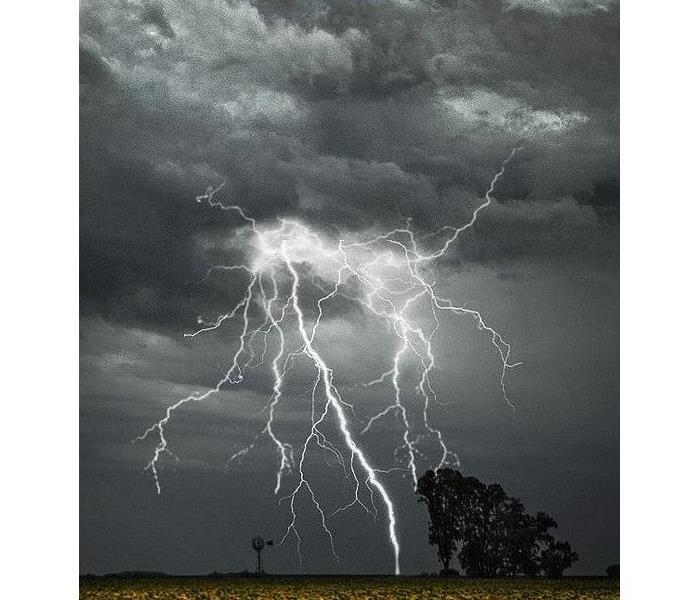 Don't take your chances. Prepare for the worst in oder to come out best.
Don't take your chances. Prepare for the worst in oder to come out best.
Don't Wait Too Late- Be Ready
Being prepared means being equipped with the proper supplies you may need in the event of an emergency or disaster. Keep your supplies in an easy-to-carry emergency preparedness kit that you can use at home or take with you in case you must evacuate.
At a minimum, you should have the basic supplies listed below:
- Water: one gallon per person, per day (3-day supply for evacuation, 2-week supply for home)
- Food: non-perishable, easy-to-prepare items (3-day supply for evacuation, 2-week supply for home).
- Medications (7-day supply) and medical items
- Sanitation and personal hygiene items
- Copies of personal documents (medication list and pertinent medical information, proof of address, deed/lease to home, passports, birth certificates, insurance policies)
- Family and emergency contact information
Consider the needs of all family members and add supplies to your kit. Suggested items to help meet additional needs are:
- Medical supplies (hearing aids with extra batteries, glasses, contact lenses, syringes, etc)
- Baby supplies (bottles, formula, baby food, diapers)
- Games and activities for children
- Pet supplies (collar, leash, ID, food, carrier, bowl)
- Extra set of car keys and house keys
Additional supplies to keep at home or in your survival kit based on the types of disasters common to your area:
- Tools/supplies for securing your home
- Extra clothing, hat and sturdy shoes
- Blankets or sleeping bags
For more information check out redcross.org
Thunderstorm Facts
8/3/2022 (Permalink)
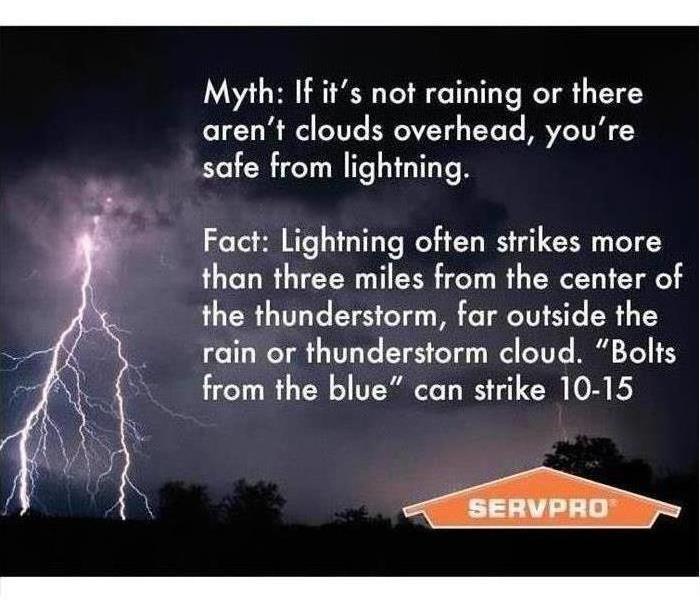 We're here to help by keeping you informed!
We're here to help by keeping you informed!
Types of Thunderstorms
It’s important to note that thunderstorms do not always produce moisture. A storm in which you see lightning and hear thunder but never feel a drop of water is known as a “dry” thunderstorm. Thunderstorms that produce hail and tornadoes are known as “supercell” storms. Storms occur either in clusters or lines; therefore, they may present as a single thunderstorm or as multiple thunderstorms hitting one after the other.
Causes
Thunderstorms are caused when moisture from the lower or mid-level part of the atmosphere mixes with warm, unstable air from the ground. Moisture and air then push upwards into the higher atmosphere to form clouds that produce thunder and lightning, as well as potential precipitation. Spring, summer and fall are most conducive to thunderstorms because the sun heats the ground and moisture is more perceptible in the air, especially in humid climates.
Thunderstorms must also be lifted to begin their formation. Some sources of lift include:
- More heat on the ground than in the air
- Changes in atmospheric conditions near mountains
- Weather front changes caused by clashing cold and hot air
- Drylines, or when moist and dry air clash
- Land or sea breezes
Any of these situations can immediately create a thunderstorm without warning, even in the middle of a clear blue day. In many cases, these storms will also be accompanied by lightning. Most will not come with hail or tornadoes, unless they occur in tornado-prone states such as Kansas, Oklahoma, Texas and Missouri.
Flash Flood Facts
8/3/2022 (Permalink)
BEFORE THE FLOOD:
- Have a qualified professional elevate the furnace, water heater and electric panel if susceptible to flooding.
- Install "check valves" in sewer traps to prevent flood water from backing up into the drains of your home or business.
- Seal walls in basement with waterproofing compounds to help avoid seepage.
DURING THE FLOOD:
- Disconnect electrical appliances if it’s safe to do so.
- Even in a panicked moment, avoid touching electrical equipment if you are wet or standing in water.
- Turn off utilities at the main switches or valves if instructed to do so.
- It’s not safe to walk through moving water- even six inches deep of moving water can make you fall, escalating the situation.
AFTER THE FLOOD:
- Listen for news reports to learn if the community's water supply is safe to drink.
- Avoid floodwaters- water may be contaminated by oil, gasoline or raw sewage. Water may also be electrically charged.
- Stay out of any building if it is surrounded by floodwaters.
- Return home only when authorities indicate it is safe.
We’re part of our local community, but we also have our national Storm Response Team to reinforce us during widespread events. This is what we prepare for. Should your home or business be affected by the recent significant rain fall or flooding- Call SERVPRO of Centreville, Marion & Selma.
We have you covered. ”Like it never even happened.”
SERVPRO's Storm Damage Methods
7/18/2022 (Permalink)
Air Movers
For more than two decades, water damage restorers have been utilizing air moving equipment for the purposes of structural drying. The reason for this is because controlled drying processes depend on evaporation – the transition of liquid water to vapor.
Several different factors influence the rate of evaporation. Most are linked directly to changes in the air around damaged materials. Therefore, the application of air movement at the surface of wet objects is essential for the successful repair of water damage in Alabama homes.
The Control Of Microbial Growth
High powered air movers are very effective when it comes to drying surface water. At SERVPRO, they are a critical tool for preventing microbial growth. Practically speaking, if water activity (aw) can be limited to a level below 0.75, the development of microbes is slower. However, if held at a level under 0.65 aw, it is difficult for any microbes to grow, even on the most vulnerable materials.
This insures our dedication to drying all damaged materials in order to reach an equilibrium with an environment below the 0.65 aw cut off. The fastest way to do this is to install air movers and direct clean, dry air over wet surfaces. Crucially, if the exposed surface of hygroscopic substances (plasterboard) get dried quickly but their interior remains wet, microbial growth is still unlikely.
The Even Distribution Of Heat And Air
As the drying process progresses, our SERVPRO team tightly regulates the humidity, temperature, and airflow within the water damaged space. When air movers get used correctly, they must redirect clean air and support the even distribution of heat to any materials which are still intolerably wet. As the job is nearing completion, the technicians can start to relax humidity and airflow controls, but they must still maintain established drying goals. Moisture tests are carried out periodically to determine how much moisture the materials in the room contain and how long it is likely to take for them to be dried out.
At SERVPRO of Centreville, Marion, and Selma, our professional team assesses water damage with proper training and experience. By using sophisticated structural drying techniques, our technicians ensure that all excess water, damp, and moisture gets eliminated. We are always available for fast, effective repairs.
(205) 926-6010
Pop-Up Showers and the Damage They Leave Behind
5/17/2022 (Permalink)
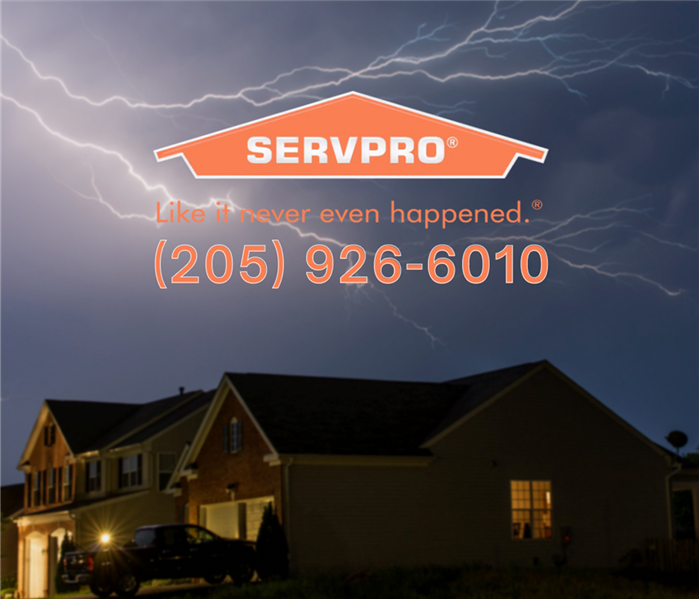 Summertime showers can be last minute and leave a trail of storm damage behind. When the unexpected happens, we are here to help!
Summertime showers can be last minute and leave a trail of storm damage behind. When the unexpected happens, we are here to help!
Summer thunderstorms can “pop up” out of nowhere. Most will be harmless and leave that pesky, humid air behind. However, others can leave downed trees, power loss, and cause flash flooding.
Our advice is to remain weather aware. Meteorologists can often predict what is coming. Unfortunately, summer showers do not always give them the advanced notice we would like. So, how do you stay prepared if you are not sure when severe weather will strike?
- Have multiple sources to receive weather alerts. Battery-powered radios, weather apps, and local weather stations are all fantastic assets to have on hand.
- Watch for cumulonimbus and stratocumulus clouds. Learn what each type of cloud means and how to spot signs of potential bad weather.
- Secure all your belongings. High winds can turn unsecured objects into missiles. Loose items such as lawn furniture and children's toys should be stored away when not in use.
- Keep your trees ten to fifteen feet away from the house. Seek professional help to cut down trees that are dying or appear unstable.
- Have an emergency kit readily available. Keep first aid items, flashlights, and batteries on hand. It is also a great idea to keep a camp stove nearby that you can use during power outages.
Thunderstorms, also known as electrical storms or lightning storms, are characterized by the presence of lightning and its acoustic effect on the Earth's atmosphere, known as thunder. Although most thunderstorms are harmless, they can cause massive problems including floods, hail, and roof damage. More potent thunderstorm cells are capable of producing tornadoes and waterspouts.
On average, only ten percent of all severe thunderstorms reach the destructive category each year. Most of these more significant, more intense storms are damaging wind events. During these storms, the most important thing you can do is to remain calm and call a professional, (like SERVPRO of Centreville, Marion & Selma), when damage occurs.
What will SERVPRO do?
Once we receive the call, our team dispatches immediately to head to your home. Our owner, Travis Boyd, will assess the damage and create a restoration plan unique to your needs while keeping you posted. Whether your home is hit by lightning, the roof is caving in, or a tree is not part of your living room décor, SERVPRO is ready to make it “Like it never even happened."
One of the most complex parts of our jobs is witnessing disastrous events with homes. We may see it every day but watching someone's home get torn apart never gets easier. Our team's work ethic, compassion, and desire to make a difference is our driving force behind assisting our community in their time of need. #communitysupport
(205) 926-6010
Hurricane Season
9/8/2021 (Permalink)
 Stay aware and prepared!
Stay aware and prepared!
Hurricane Season is Here
Hurricane Ida made it's big appearance last week, causing water and wind damage. Hurricanes are one of the most dramatic, damaging and life altering events that can occur in our state.
SERVPRO of Centreville, Marion, and Selma wants to make sure you are prepare for further hurricanes this season.
Here are some tips:
- Listen to NOAA Weather Radio or to commercial radio or television newscasts for the latest information. In any emergency, always listen to the instructions given by local emergency management officials.
- Be alert to changing weather conditions. Look for approaching storms.
- Many communities have text or email alerting systems for emergency notifications. To find out what alerts are available in your area, search the Internet with your town, city, or county name and the word “alerts.”
- Know where to go. If you are ordered to evacuate, know the local hurricane evacuation route(s) to take and have a plan for where you can stay. Contact your local emergency management agency for more information.
According to msema.org, prepare a three to five-day disaster kid that should contain:
- Flashlight and battery-powered radio with additional batteries.
- Canned and non-perishable food.
- Bottled water.
- Toiletry items.
- Pet food and pet supplies.
- Medicine and prescription medication.
- Copies of important family papers and documents.
Preventing Damage During Spring Showers
4/6/2021 (Permalink)
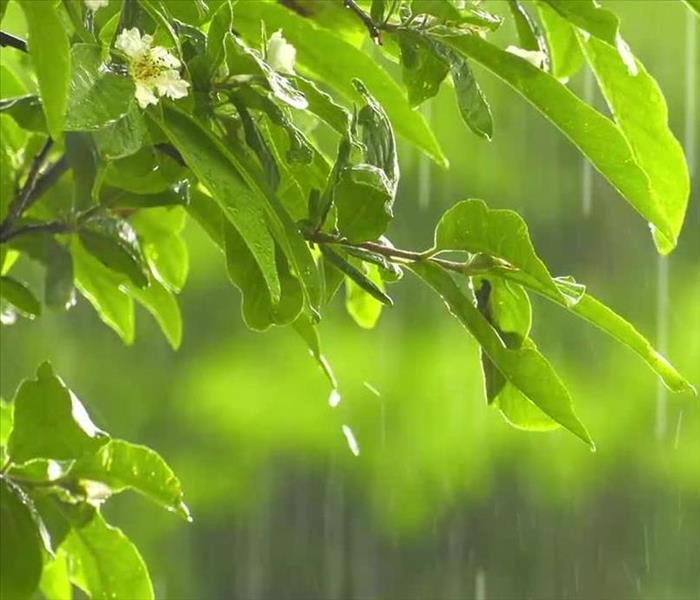 April showers may bring May flowers. But, storm damage brings SERVPRO — and we'd like to prevent that, believe it or not!
April showers may bring May flowers. But, storm damage brings SERVPRO — and we'd like to prevent that, believe it or not!
April Showers Can Bring More Than Flowers
This is true, but unfortunately showers can also bring severe weather threats such as hail, high winds, tornadoes and lightning. According to the National Weather Service, thunderstorms cause more than $1 billion in property damage each year. Without proper home preparation and maintenance upkeep, the damage could be very costly if severe weather came through. In Alabama, the weather changes one day to the next. Below are some helpful tips to prevent spring storms from damaging your home.
Spring Storm Tips:
1. Clean the gutters. Cleaning out any leaves or debris that may have accumulated in the gutters will help prevent water damage. Check to make sure the downspout directs water away from the foundation, and add extensions if necessary to keep the water away from your house. It’s also a good plan to install gutter guards. These will protect your gutters from clogging and ensure that water does not accumulate on the roof.
2. Maintain roof maintenance. Replace roof shingles that are cracked or loose. This will help prevent damage from roof leaks.
3. Check the caulking. It is important to check caulking for decay around doors, windows, corner boards, and joints, and re-caulk where needed. Be sure the seals are tight to improve insulation and prevent water damage.
4. Look around the yard. Trim your trees and remove dead or loose branches to prevent them from becoming projectiles during a storm.
5. Prepare your patio before a storm. When a storm is approaching, be sure to move all patio furniture, trash cans and any other loose outside items to your shed or garage – these could become flying projectiles.
Cover Your Bases on Flood Damage
3/1/2021 (Permalink)
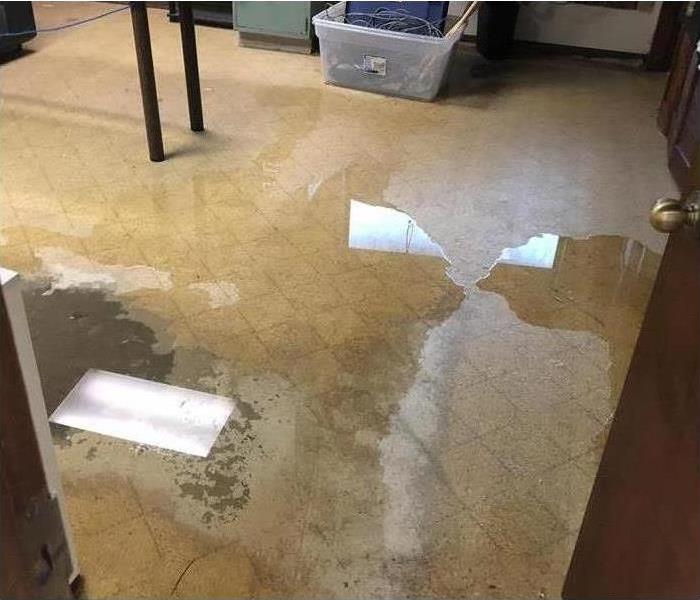 Flood waters can creep in through outside doors, causing damage as time passes.
Flood waters can creep in through outside doors, causing damage as time passes.
What's classified as a flood?
Floods are considered excess water in areas that are normally dry, causing water damage to a structure. Locally, they result from prolonged or very heavy rainfall, severe thunderstorms, or even snowmelt (as we saw with the Ice/Winter Storm of 2021).
Common types of flooding
- Slow onset floods
- Rapid onset floods
- Flash floods
Flood warnings
Usually, a reasonable warning period is possible except in case of flash floods.
Common terms used by the meteorological department to describe the warnings for flooding are as:
- Minor flooding: Causes inconvenience, closing small roads and low-level bridges.
- Moderate Flooding: Low-lying areas inundated, requiring removal of stock, equipment and evacuation of isolated homes. Main road and rail bridges may be covered.
- Major flooding: Higher areas inundated, towns and properties isolated, and extensive damage.
- Local flooding: Intense rainfall, some high run-off, but usually no flooding in main streams;
- Significant river rises: This warning is issued if it is not certain that the initial flood levels will be exceeded in the main streams. It makes people aware that appreciable rises are expected.
After a Flood
The following are guidelines for the period following a flood:
- Listen for news reports to learn whether the community’s water supply is safe to drink.
- Avoid floodwaters; water may be contaminated by oil, gasoline, or raw sewage. Water may also be electrically charged from underground or downed power lines.
- Avoid moving water.
- Be aware of areas where floodwaters have receded. Roads may have weakened and could collapse under the weight of a car.
- Stay away from downed power lines, and report them to the power company.
- Return home only when authorities indicate it is safe.
- Stay out of any building if it is surrounded by floodwaters.
- Use extreme caution when entering buildings; there may be hidden damage, particularly in foundations.
- Service damaged septic tanks, cesspools, pits, and leaching systems as soon as possible. Damaged sewage systems are serious health hazards.
- Clean and disinfect everything that got wet. Mud left from floodwater can contain sewage and chemicals.
SERVPRO of Centreville, Marion, and Selma is always here to guide you in the right direction after any disaster.
(205) 926-6010
Keep Your Storm Damage Minimal
12/13/2019 (Permalink)
Reduce the Damage
-Stop the water at its source
-Take small electrical devices out from areas with excess water if safe to do so and turn off electricity to the home.
-Do not walk on wet carpeting.
-Take out small furnishings from areas that are carpeted or put aluminum foil under the legs of the furniture. This will stop permanent rust of furniture stains.
-Pin up furniture skirts and hang draperies, so they don’t come into contact with wet floors.
-Take out any breakables, high-value items, and moisture-sensitive items, plus any items that could stain the floor coverings. Look under beds and other furnishings.
-Plan for the restoration crews to move furniture to areas that are dry.
-Always wash your hands after you handle any items which are damaged.
-Avoid the risk of electric shock. Don’t use a home or shop vacuum to take the water out of your home.
-Do not be tempted to turn on heating, fans or air conditioning units, as they could spread contamination if the situation is related to sewage.
We Will Get the Water Out
-We’ll bring extraction equipment into your home to remove any water that is freestanding.
-Soaked and damaged carpeting and padding will be removed and need to be replaced.
-We use professional grade dehumidifying and drying equipment to dry the affected areas and get the humidity levels in your house back to normal. Additional tools will be used to find pockets of water that are hidden.
-Proper drying and extraction techniques will help minimize the possibility of damage that is secondary, like potential microbial growth.
-Our professionals will monitor daily the drying process and reposition the drying equipment as needed.
Prepare For Flooding
12/13/2019 (Permalink)
If you experience flooding during a storm event then pay attention to these tips:
Before
- Build an emergency kit.
- Make a family communications plan.
- Tell an adult if you hear a flood warning on the TV or radio.
During
- Listen to authorities and safety officials.
- If there is any possibility of a flash flood, move immediately to higher ground.
- Help your family move important items to an upper floor.
- Do not walk through moving water. Even 6” of water can make you fall.
After
- Stay away from flood water. It could be contaminated, meaning contain dangerous substances.
- Stay away from moving water. It can knock you off your feet.
- Stay out of the way of emergency workers so they can do their job easily.
Call us if you need us!
How to help prevent flooding to your home in Helena or Great Falls due to a storm.
5/31/2019 (Permalink)
According to the National Flood Insurance program flooding is the most common natural disaster in the United States causing $2.7 billion in losses between 2001 and 2010. Flooding is not covered by most homeowner’s insurance policies so it may be necessary to buy a separate flood policy for your home.
Here are a couple of tips to keep water from entering your home during a heavy rain event:
1. Fix foundation leaks that may allow water to enter your home.
2. Make sure your roof is secure and protected.
3. Clear gutters and drains
If water ever floods your home, getting someone on site as soon as possible is key to keeping the amount of damage to a minimum. SERVPRO of Centreville, Marion, and Selma is ready to respond at any time and also provides a free assessment and estimate.
Reasons to get an ERP for your business
4/26/2019 (Permalink)
When disaster strikes, the devastation can be tremendous. Extensive damage or loss of property can lead to uncertainty about the future of your business. To lessen the confusion that comes with a disaster, you need a plan of action in place before the devastation occurs. To protect your business in Centreville, Marion, and Selma, AL an emergency profile is a free and necessary service. This service can give you peace of mind in many ways:
1. Protect your assets. One of the most important uses of this type of profile is to protect your business’s physical location. An accurate assessment of your facility before a disaster is imperative. This assessment should include details of your business that would prove useful in the event of an emergency, such as contact information and safety details of the location. Your local emergency restoration service may provide a facility evaluation for no charge to your business.
2. Protect your clients. As a business owner, your clients are the priority. In an emergency, each client needs to be assured that your business will resume the operations and service of which he or she is a patron. An emergency profile lets your clients know that you are prepared for any emergency, and it can show that you value the loyalty shown to your business.
3. Protect your future. Only half of businesses that suffer an unexpected accident remain operational. Researchers have found that many of those businesses that do remain open have some type of disaster plan protocol. Within minutes, SERVPRO’s easy-to-use Emergency Ready Profile application provides you with the necessary tools to begin safeguarding your business with your own emergency plan protocol. With the ERP app and the experts from SERVPRO on your side, you will be able to better ensure the future operation of your business entity in the event of unforeseen circumstances.
Creating an emergency profile is an excellent way to protect your business and its future operation, as well as the clients that allow your business to thrive. You can operate your business with the assurance that you are prepared for any disaster that could arise.
When storm strikes CMS is ready!
12/17/2018 (Permalink)
As a flood damage restoration specialist, SERVPRO of Centreville, Marion, and Selma utilizes and maintains and inventory of state of the art equipment and houses a staff of highly trained and certified personnel to return your property to a pre-storm condition.
Faster To Any Size Disaster
Being a locally owned and operated business enables us to respond fast with the correct resources. This is critical, as a fast response minimizes potential secondary damage and reduces the restoration cost.
Storm & Flood Resources
When a storm strikes, our team will measure our resources to handle a either a large storm or a flooding disaster. We have continuous access to equipment and personnel from a network of 1,650+ Franchises across the country and elite Disaster Recovery Teams that are strategically located throughout the entire United States.
When Storm or Flood Damage Strikes, Call the Experts at SERVPRO of Centreville, Marion, and Selma. (205)-926-6010.
https://www.SERVPROcentrevillemarionandselma.com/
Storm damage is no game
12/12/2018 (Permalink)
Storm damage can happen anywhere, not too long ago hurricane Micheal decided to come through the Florida pan handle coming up through the states of Alabama, Georgia, and Mississippi following all the other hurricanes. He left a lot of water on the ground all throughout our six counties. We had three water damages come from Micheal, and they were all from, trees hitting the roof and making the water come through the roof going all the way down through the houses. These problems can be prevented by trimming any of the trees that branches could land on your roof, and cut down all the trees that count crush your house have them no closer than 20-30 feet away from your house. Doing this could prevent a major storm damage, if the tree were to land on your house you'd have to call SERVPRO, then after us you would need a contractor, and he'd have to build you a new roof, which could all be prevented.
Weather in Alabama
12/4/2018 (Permalink)
Living in Alabama we never know if its going to be freezing, warm or hot outside, what ever Alabama decides to do you need to be prepared for freezing pipes. One way to avoid freezing pipes is to barely leave your sink faucet on where its dripping water. if you have a crawlspace, and not a concrete slab, you can take a small mini heater and place it right inside to make it warm under your house. Another way to avoid freezing pipes is to purchase heating tape from your local, Lowes, Home Depot, or Hard wear store. the wrap it around your pipes and plug it in which will allow the pipes to stay fairly warm. One last way to avoid busting pipes is insulate your pipes to avoid cold freezing air from flowing past your pipes.
Safety during storms
5/18/2018 (Permalink)
Severe weather can happen anytime, anywhere. Each year, Americans cope with an average of the following intense storms:
- 10,000 severe thunderstorms
- 5,000 floods or flash floods
- 1,000 tornadoes
- 2 landfalling deadly hurricanes
Approximately 98% of all presidentially declared disasters are weather-related, leading around 500 deaths per year and nearly $15 billion in damage. Knowing your risk of severe weather, taking action and being an example are just a few steps you can take to be better prepared to save your life and assist in saving the lives of others.
Know Your Risk. The first step to becoming weather-ready is to understand the type of hazardous weather that can affect where you live and work, and how the weather could impact you, your business and your family. Check the weather forecast regularly, obtain a NOAA Weather Radio, and learn about Wireless Emergency Alerts. Severe weather comes in many forms and your shelter plan should include all types of local hazards.
Take Action. Take the next step in severe weather preparedness by creating a communications plan for your home and business. Put together or purchase an emergency kit. Keep important papers and valuables in a safe place.
Be an Example. Once you have taken action to prepare for severe weather, share your story with co-workers and family and friends on Facebook or Twitter. Your preparedness story will inspire others to do the same.
Build an Emergency Supply Kit
- Water (1 gallon per person per day)
- Food (non-perishable 3-day supply)
- Manual can opener
- Battery operated radio, preferably a NOAA Weather Radio
- Flashlight and extra batteries
- First aid kit
- Whistle to signal for help
- Clothing
- Dust masks or bandanas
- Plastic sheeting, garbage bags and duct tape
- Wrench or pliers to turn off utilities
- Hygiene items
- Important documents; copies of insurance policies, identification and bank account information
- Cash
- Fire extinguisher
- Matches in a waterproof container
Contact SERVPRO of Centreville, Marion, and Selma (205)-926-6010 for 24 hour service and more readiness tips and tools on how to be prepared for severe weather.
Flooding
11/21/2017 (Permalink)
Floods are one of the most common and widespread natural disasters in the United States.
There is always potential for flood damage no matter where you live. According to the American Red Cross floods cause more damage in the United States every year than any other weather related disaster. The American Red Cross offers these flood safety tips:
-Stay away from floodwaters. If you come up on a flowing stream where water is above your ankles, stop, turn around and go another way. Six inches of swiftly moving water can sweep you off of your feet.
-If you approach a flooded road while driving, turn around and go another way. If you are caught on a flooded road and waters are riding rapidly around you, get out of the car quickly and move to higher ground. Most cars can be swept away by less than two feet of moving water.
-Keep children out of the water. They are curious and often lack judgment about running water or contaminated water.
If flooding occurs and affects you, call SERVPRO of Centreville, Marion and Selma. Even minor floods have potential to cause major damage. We are faster to ANY size disaster. Let us help you get your life back in order.
Severe Weather
11/21/2017 (Permalink)
Since SERVPRO Corporate partners with the American Red Cross we love sharing their tips on different occasions. Here is some information on severe weather!
Check out www.redcross.org for more information!
TORNADOES Tornadoes can strike without warning and destroy a community in seconds. Before a tornado warning is issued for your area, here are some things you should do:
1. Know your community’s warning system.
2. Pick a place where family members can gather if a tornado is headed your way. It could be your basement or, if there is no basement, a center hallway, bathroom, or closet on the lowest floor. Keep this place uncluttered.
3. If you are in a high-rise building and don’t have enough time to go to the lowest floor, pick a place in a hallway in the center of the building.
4. Remove diseased and damaged limbs from trees.
5. Move or secure lawn furniture, trash cans, hanging plants or anything else that can be picked up by the wind and become a projectile.
THUNDERSTORM SAFETY STEPS Thunderstorms injure an average of 300 people every year, and cause about 80 fatalities. Here are the top thunderstorm safety steps you should follow:
1. If you can hear thunder, you are close enough to the storm to be struck by lightning. Go to safe shelter immediately.
2. As the storm approaches, take shelter in a building.
3. If you are driving, pull off the roadway and park. Stay in the car with the windows closed and turn on the emergency flashers. Avoid touching metal or other surfaces that conduct electricity in and outside of the vehicle.
4. If you are inside, unplug appliances and avoid using the telephone or any electrical appliances. Avoid taking a bath or shower, or running water for any other purpose.
5. If you are caught outside and cannot reach a safe building, avoid high ground, water, tall, isolated trees and metal objects such as fences or bleachers. Picnic shelters, dugouts and sheds are not safe.
FLOODING Heavy rains could fill rivers and streams, bringing flooding to the area. If your neighborhood is threatened with the possibility of flooding, here are some things you should do:
1. Be prepared to evacuate at a moment’s notice. When a flood or flash flood warning is issued for your area, head for higher ground and stay there.
2. Stay away from floodwaters.
3. If you come upon a flooded road while driving, turn around and go another way. If you are caught on a flooded road and waters are rising rapidly around you, get out of the car quickly and move to higher ground. Most cars can be swept away by less than two feet of moving water.
4. Keep children out of the water.
5. Be especially cautious at night when it is harder to recognize flood danger.
DOWNLOAD EMERGENCY People should download the free Red Cross Emergency App to receive emergency alerts and information about what to do in case of tornadoes, flooding and other disasters, as well as locations of shelters. The App also includes emergency first aid information and a Family Safe feature which allows people to instantly see if loved ones are okay. The free Emergency App is available in app stores by searching for the American Red Cross or going to redcross.org/apps.
It's getting cold outside...
11/21/2017 (Permalink)
Whether there is heavy rain, freezing temperatures, damaging winds, or sleet and snow; all of these can cause property damage. You can be prepared so here are some tips to help you:
-Check for tree limbs and branches that might have fallen.
-Roofs, pipes and gutters should all be inspected and make sure they are in proper working order. Clear gutters from debris, a damming effect could cause roof damage or interior water problems. Downspouts should be facing away from the home or building.
-Clean your chimneys and exhaust systems from debris.
-Test your gas lines for leaks.
-Inspect your property for proper drainage.
-Protect pipes from freezing by allowing water to drip when temperatures dip below freezing. If any pipes are under cabinets leave the cabinets open. Make sure exterior pipes are properly insulated.
-If there are any outdoor faucets, you might want to shut the water off.
-Make sure all exterior doors and windows have sufficient weather stripping.



 24/7 Emergency Service
24/7 Emergency Service







